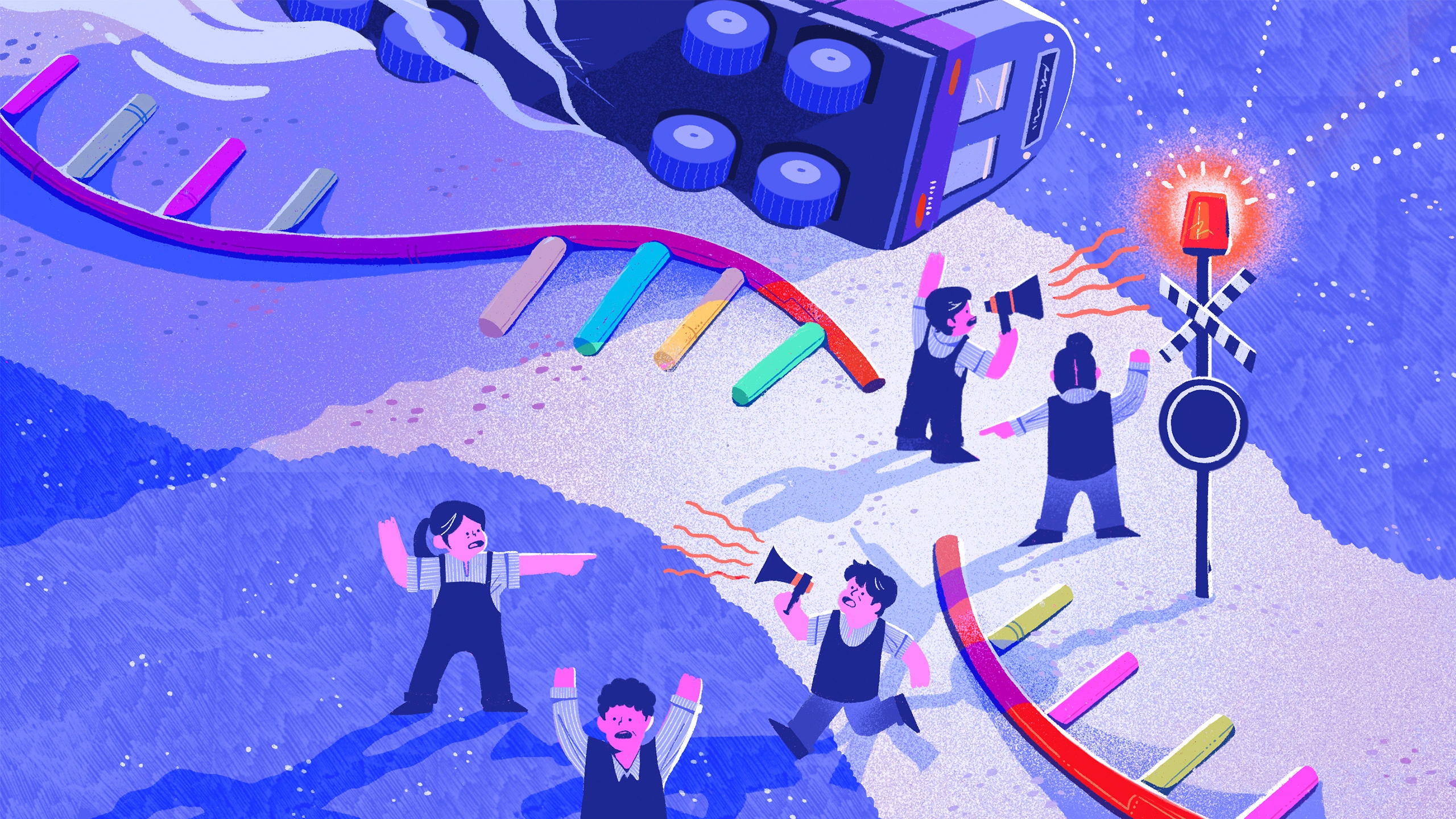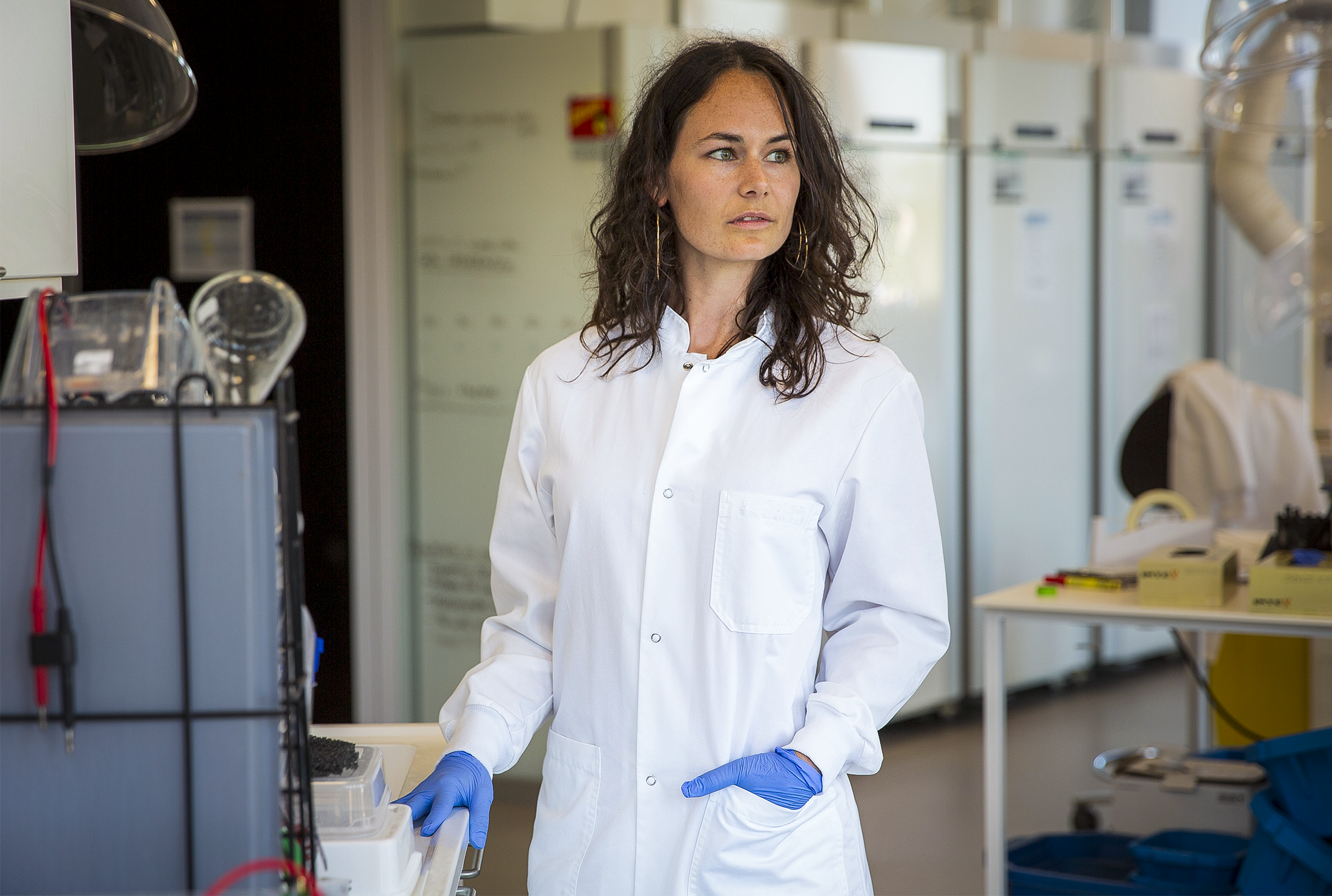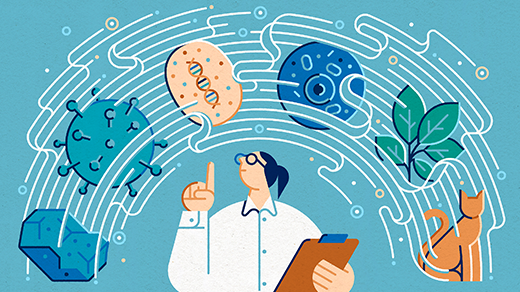RNA Is the Cell’s Emergency Alert System

Wei-An Jin/Quanta Magazine
Introduction
When the sun shines on your skin, what does it hit? When it causes a burn, what went wrong?
Underneath that pain is your cells’ emergency response to DNA damage. When a hazard, such as ultraviolet light, ionizing radiation or certain chemicals, damages DNA, the cell needs to respond at breakneck speed. Ideally it either repairs the damage to its genomic information repository, or else sacrifices itself through a controlled cell death process. If it doesn’t move fast enough, it risks the more dangerous outcome of death by necrosis — an explosive, uncontrolled death that damages its neighbors — or passing mutated DNA to its descendants, which could develop into cancer.
It is therefore urgent for a cell to identify DNA damage as soon as possible. But the genome is enormous; when DNA mutates, the mutation may not be found in a timely manner, if at all. To remain in control of its fate, a cell needs some kind of DNA-damage alarm.
Researchers have now identified the cellular alarm system, which surprisingly doesn’t involve DNA itself. Instead, when mutated molecules of DNA’s close cousin RNA pile up in a cell and interfere with molecular operations, a signaling pathway is triggered, raising the alarm that something is deeply wrong with the DNA code that must be addressed urgently. These findings were published in the journal Cell in 2024.
Most recently, a team led by Anna Constance Vind, a molecular biologist at the University of Copenhagen, confirmed that RNA is at the center of this rapid and intricate damage response in mammalian cells — specifically in those of sunburned mice, which suggests it’s happening in human cells too. That work was published in Molecular Cell.

Anna Vind’s research into cells’ emergency alarm system reveals yet another central role for RNA in cell biology. “People are now seeing that RNA does matter,” she said.
Anton Willemann/Københavns Universitet
“What the cell is trying to do is make decisions about whether to live or die based on how damaged the DNA is. If DNA is too damaged, there will be mutations that are inherited,” said Rachel Green, an RNA biologist at Johns Hopkins University who co-authored the Cell study. “But amazingly, it’s the RNA that signals that. That’s the remarkable observation.”
Collision Course
Scientists are as susceptible to myths as anyone else. The popular understanding was that DNA damage is detected by proteins that interact directly with DNA. As these proteins crawl along a DNA strand, they can get stuck on lesions, crosslinks or mutations, the way you might run a piece of string between your fingers until you find a knot. The cell can then try to repair the damaged DNA, but if the injury is too dire, it will undergo apoptosis, in which a cell intentionally bundles its contents and disposes of itself safely without damaging nearby cells.
But that story never really made sense. Because of the genome’s vast size, and the fact that DNA is crawled and copied only during one specific part of a cell’s life cycle, any DNA-based alarm system would be slow and cumbersome. Intrinsic DNA repair mechanisms can take upward of 16 to 24 hours. But once DNA is damaged, the cell makes its fateful choice much faster than that.
“The decision to live or die is made in 15 to 30 minutes,” said Niladri Sinha, a postdoctoral researcher in Green’s lab and lead author of the Cell study. “You don’t want the problem to spread; you make the decision to stop it early.”
In addition, a direct causative link between DNA damage and the inflammatory immune response to cellular threats was never firmly established in a living organism.
To resolve these discrepancies, Vind needed to intentionally damage DNA in the lab and follow the cell’s response. So her lab gave mice sunburns. They shaved two groups of mice and shone UV light on them. The first group consisted of normal mice, or “wild-type.” The mice in the second group were genetically engineered to lack a protein called ZAK.
ZAK is associated with ribosomes, the cellular factories that process some types of RNA to make proteins. It’s one of a coterie of proteins that help the ribosome, for example by loading it with RNA, assisting with protein synthesis and checking on its progress, and it sits at the top of a signaling cascade that transmits information from the ribosome to the rest of the cell. Years of research placed ZAK as a central coordinator in a cellular response network that responds to damage from UV rays. Those findings focused on cells and worms growing in a dish; Vind wanted to see how the pathway played out in a larger, more humanlike organism.
When UV light shines into cells, it can mutate DNA; importantly, it makes the same kinds of mutations in RNA. In the skin cells of the sunburned mice, Vind’s group saw that ribosomes tripped over damaged RNA. The ribosomes could not parse some mutations and trepidatiously tiptoed over physical roadblocks created by more severe damage. They slowed down, stopped working and started crashing into one another.
That was when the researchers found ZAK leaping into action. The protein persistently hovers, acting only when two ribosomes are physically touching, such as when they are colliding. In the skin cells of the wild-type mice, within six hours of UV exposure, ZAK kicked off a series of cellular reactions in response to ribosomal slowdowns and collisions. Anyone who has ever gotten a sunburn is familiar with these reactions: inflammation caused by an influx of immune cells into the area, resulting in swelling and redness.
“ZAK starts a signaling pathway like an alarm,” Sinha said. “The extent of its activation is the commitment to death.” The more colliding ribosomes there are, the more ZAK signals. When it reaches some critical point, the cell chooses to undergo apoptosis rather than risk necrosis or cancer. The cell is trying to protect neighboring cells, the body itself, and its DNA — the coding information that will get passed down to the next generation.
The mice that lacked ZAK, however, reacted completely differently. Six hours post-UV treatment, there was still no inflammation. The rapid response to damaging UV light was completely absent. It took one or two days after the UV exposure for these mice to become red and inflamed like the wild-type mice.
The results show that ZAK is necessary for cells to rapidly detect DNA damage. And ZAK enables this by sensing damage not to DNA, but to RNA.
Do or Die
The symptoms of sunburn occur because the cell’s ribosomal alarm system activates an acute protective system, the ribotoxic stress response (RSR). When a cell sees that ribosomes are behaving strangely — such as colliding with one another, which they don’t usually do — the cell slows its metabolism down to decide between a repair attempt and a controlled death.
What makes RSR a good, prompt alarm system is the frequency with which a cell uses RNA, which is all the time. Cells are almost always creating, touching, manipulating or otherwise handling RNA in one form or another. It could be messenger RNA that’s getting translated into proteins, noncoding RNA that regulates gene expression, or ribosomal RNA that is used to build the molecular machines — a persistent need for cells and one of their biggest energy sinks.
“Logically, the ribosome getting stuck is a much more sensitized system to finding the damage because ribosomes are super dense on RNA,” said Craig Kaplan, an RNA biologist at the University of Pittsburgh who was not involved in these studies. “The ribosome getting stuck is the fastest way to detect damage, and what we’re finding in these papers is that it’s the dominant way.”
It’s not only the cell’s familiarity with RNA that makes it an ideal alarm molecule, but also its sheer ubiquity and abundance, and its pliability and ease of manufacture.
“You can think of [the ribotoxic stress response] as an amplification of an alarm,” said Lydia Contreras, a molecular biologist at the University of Texas, Austin, who wasn’t involved in the studies. “You can make a lot of copies of an RNA, so it’s like a loudspeaker. … This is one of the cheapest ways, molecularly,” to raise a fuss, she said. “You’re communicating quickly because you’re printing them so quickly.”
Plus, it makes a terrific amount of sense that a stalled ribosome should be a red flag for a cell. A stopped ribosome has not finished making its protein, and partially finished proteins can block the activity of complete, healthy ones, which can be toxic and even deadly. These are messes a cell would rather address before they pile up and create serious problems.
Beyond sunburn, the RSR is the pathway that sends a do-or-die signal in response to almost any cellular challenge. It turns on when a cell is starving. It turns on when a cell is poisoned with ricin. It turns on when a cell is overtaken by a virus. Detecting the crash of ribosomes and maintaining a healthy protein translation system is therefore critical for all cells, at all stages of life and in almost any situation.
To Kaplan, the RSR is a beautiful example of a cell’s internal language and the indirect ways it can evolve to access the information it needs to survive. “Cells don’t have a little guy that directs traffic and explains to the cell what’s going on in words. They don’t use that kind of language. One of the things about biology is that evolution has coupled a particular event” — such as ribosomes crashing into each other — “with a particular outcome” — a potential physical and cellular emergency.
“Sometimes you detect things indirectly,” he said. “That’s what evolution does.”



